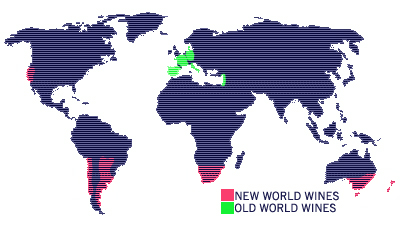
When someone says a wine is New World or mentions New World wines, they are talking about wines that come from non-traditional wine regions of Europe and the Mediterranean basin. The traditional areas are Austria, France, Germany, Italy, Portugal, Romania and Spain with Italy and France at the forefront of the world’s wine production.These traditional regions are called Old World and are known as such mostly because of how the wines of the area are produced according to their geography and the environment. This is known as terroir. Old World wine makers follow a long history of traditional practices in winemaking and viticulture, whereas a New World wine is considered more experimental in its approach.
New World Wine Regions
Pretty much any wine producing country outside of the Old World wine region is considered New World. This includes The United States, Australia, Chile, Argentina, New Zealand, Canada, Mexico and surrounding countries of Europe. One characteristic of wines from the New World was that most of the grapes used were grown in hot climates. Old world wines have more temperate climes which means shorter hang times, whereas New World grapes have longer growing seasons and tend to be riper. This creates wines that are fuller and have more body and higher alcohol content.
Old World vs New World Wine
There are other minor differences between the two worlds. Labeling is one. As most wines didn’t have a very long history to connote vineyards as their selling point, and because most New World winemakers sourced their grapes from many vineyards for consistency, wineries adopted using the varietal as the prime identifier. It’s easy to differentiate old world wines vs new world wines by their label alone. A wine from France often has the region as the identifier of the type and quality of the wine. For example, you will most likely see “Chateau something or other” or “Domain de whatever vineyard” on a French wine. An Australian wine will have the producer and varietal (such as Cabernet Sauvignon) on the label. These are minor but very noticeable subtleties in old world wines and new world wines. Branding is another form of differentiation. Old World wine regions are often centralized and small with one vineyard having its own style of wine making compared to a vineyard across the street. New world vineyards are extensive and can span several regions. Marketing New World regions is done through branding; usually something that makes the wine stand out from others on the shelf. Old World relies on the reputation of their vineyard to sell their product, whereas the New World has adopted marketing techniques like putting animals on labels. The Australian “critter wine” is one example of branding.
Branding is still the top marketing avenue for most New World wines but as vineyards age and the wine making techniques are honed, wine regions in places like the United States have begun to rely more on the Old World approach of appellation branding. A good example of this is the AVA (American Viticultural Areas) of California: Napa Valley, Central Coast, Sonoma all of these have their own characteristics defined by differing terroir. The AVA designation doesn’t measure quality; it just spells out what varietals are best suited to the area of designation.


Speak Your Mind